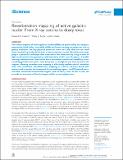Reverberation mapping of active galactic nuclei: From X-ray corona to dusty torus
Author(s)
Cackett, Edward M; Bentz, Misty C; Kara, Erin
DownloadPublished version (2.859Mb)
Publisher with Creative Commons License
Publisher with Creative Commons License
Creative Commons Attribution
Terms of use
Metadata
Show full item recordAbstract
The central engines of active galactic nuclei (AGNs) are powered by accreting supermassive black holes, and while AGNs are known to play an important role in galaxy evolution, the key physical processes occur on scales that are too small to be resolved spatially (aside from a few exceptional cases). Reverberation mapping is a powerful technique that overcomes this limitation by using echoes of light to determine the geometry and kinematics of the central regions. Variable ionizing radiation from close to the black hole drives correlated variability in surrounding gas/dust but with a time delay due to the light travel time between the regions, allowing reverberation mapping to effectively replace spatial resolution with time resolution. Reverberation mapping is used to measure black hole masses and to probe the innermost X-ray emitting region, the UV/optical accretion disk, the broad emission line region, and the dusty torus. In this article, we provide an overview of the technique and its varied applications.
Date issued
2021Department
MIT Kavli Institute for Astrophysics and Space ResearchJournal
iScience
Publisher
Elsevier BV
Citation
Cackett, Edward M, Bentz, Misty C and Kara, Erin. 2021. "Reverberation mapping of active galactic nuclei: From X-ray corona to dusty torus." iScience, 24 (6).
Version: Final published version